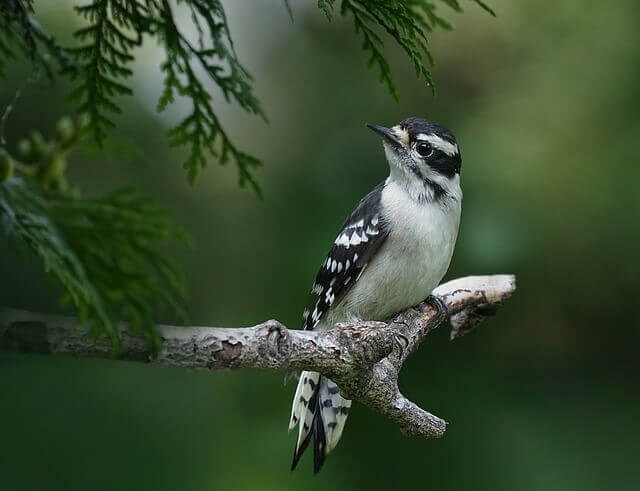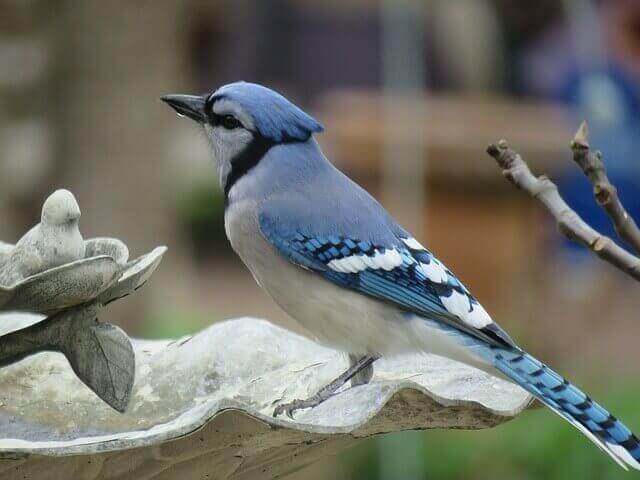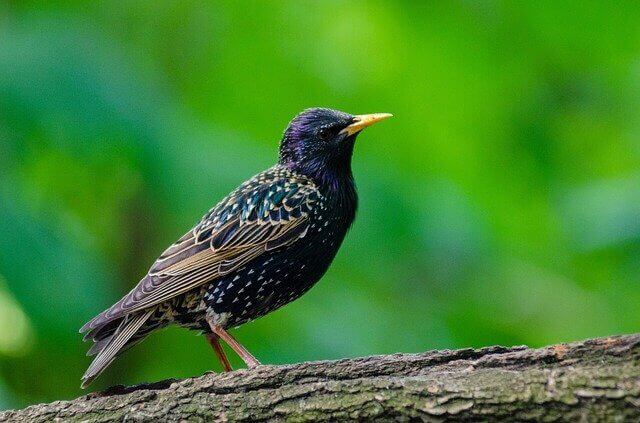Embark on a captivating journey through Alberta’s diverse birding landscape with our comprehensive guide. This Ultimate Guide highlights the 45 most common birds found throughout the Wild Rose Country, offering detailed insights into their habitats, behaviors, and distinctive characteristics.
Whether you’re a dedicated birder, an outdoor enthusiast, or simply curious about Alberta’s unique birdlife, this guide provides a fascinating exploration of the avian wonders that grace this scenic province.
Table of Contents
- 1 Most Common Birds In Alberta
- 1.1 Black-billed Magpie
- 1.2 Black-capped Chickadee
- 1.3 American Robin
- 1.4 Common Raven
- 1.5 American Crow
- 1.6 House Sparrow
- 1.7 Downy Woodpecker
- 1.8 Northern Flicker
- 1.9 Red-breasted Nuthatch
- 1.10 Red-winged Blackbird
- 1.11 Blue Jay
- 1.12 European Starling
- 1.13 Tree Swallow
- 1.14 Rock Pigeon
- 1.15 White-breasted Nuthatch
- 1.16 Yellow-rumped Warbler
- 1.17 Dark-eyed Junco
- 1.18 House Finch
- 1.19 Yellow Warbler
- 1.20 Clay-colored Sparrow
- 2 Creating a Bird-Friendly Backyard
- 3 Conclusion
- 4 Author
Most Common Birds In Alberta
Black-billed Magpie

The black-billed magpie has a wide distribution, This bird is a highly adaptable and flexible, and can be found in a wide variety of habitats such as parks, and suburban areas. In early spring, the bird comes out of its berry bushes to forage for food in the open meadows or fields.
They are very active at this time of year, flying from one bush to another, looking for berries and other foods. By late February the black-billed magpie has already returned to its nesting area and will hold its nest for the coming months.
- Frequency: 49.95% (eBird)
- Color: Iridescent blue plumage, has shorter and rounder wings, and a very long tail.
- Habitat: Towns, fields, stream corridors, feedlots
- Range: USA and Canada
- Size: 18″ – 24″ inches long
- Weight: 167 – 216 grams
- Diet: Insects, seeds, carrion, berries, rodents, eggs, nuts, garbage, pet food.
- Family: Corvidae
- Genus: Pica
Black-capped Chickadee
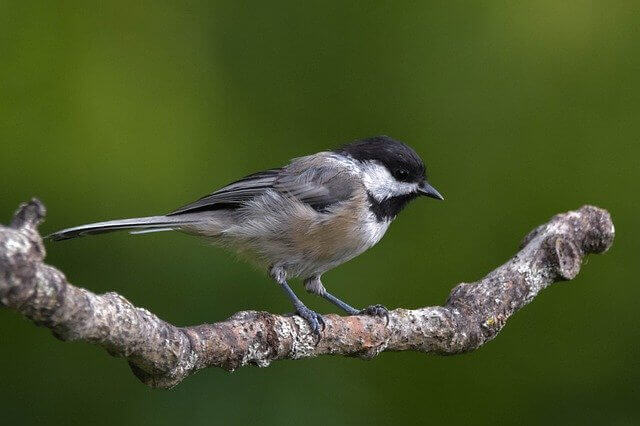
The Black-capped Chickadee, is a small, nocturnal, North American bird species which usually lives in mixed and deciduous forests in wooded areas. It is now considered endangered in many parts of its former range due to loss of its coastal plain habitat.
It has been a staple of the eastern deciduous forest for many years. Likewise, it is now only found in three mountainous areas of Canada and the USA, where it occurs in scattered flocks. Furthermore, it’s an exceptionally fast mover, and descends quickly from the trees to forage on the ground.
- Frequency: 45.64%
- Color: Black-cap, white on face, white/reddish-brown flanks
- Habitat: Deciduous and mixed forests, backyards, parks
- Range: USA and Canada
- Size: 11.5 -16 cm length
- Weight: 8 – 15 grams
- Diet: Insects, seeds, berries
- Family: Paridae
- Genus: Poecile
American Robin
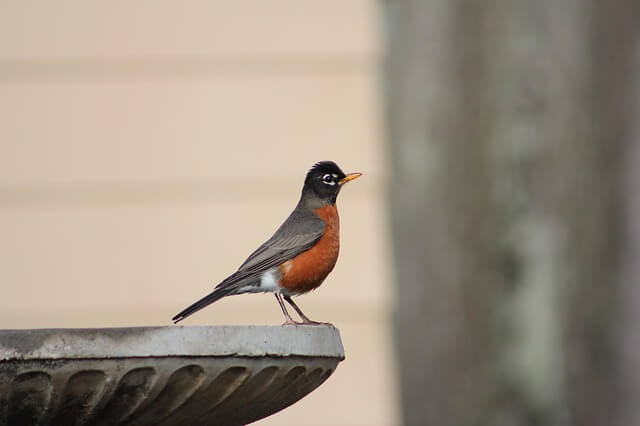
The American Robin bird species, is a widespread and highly successful songbird in both North America, and in Europe. This bird species is an adaptable traveler, having the ability to move from one branch to another and to find a new habitat every year.
They can be found throughout most of North America, except for the southern states, but are particularly common in the west and upper Midwest of the United States. Robins have also been found in southern Canada and Alaska. This is also where they are most popular, especially in roadside bird feeders and bird baths.
- Frequency: 33.54%
- Color: Mostly brown on the back with an orange colored breast
- Habitat: Wooded areas, backyards, parks, fields
- Range: USA, Canada, Mexico
- Size: 12 – 16″ inches
- Weight: 72 – 95 grams
- Diet: Fruits, berries and insects (earthworms, beetles, caterpillars
- Family: Turdidae
- Genus: Turdus
Common Raven
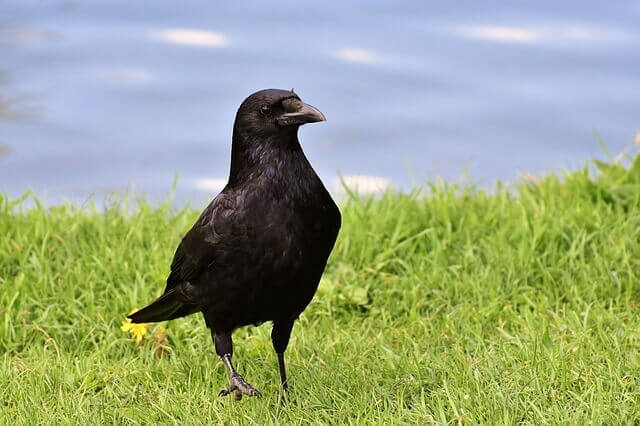
The Common Raven, is a large-sized all black passerine bird found all over the Northern Hemisphere, it has been the most widely distributed of the corvids, differing in size and distribution between North and South America. Occasional sightings have been reported in the Caribbean, Central America, the Pacific Islands, South Africa, Australia, Alaska, and even as far south as China.
They live in fields, swamps, fields near springs and streams, and in the mountains. An animal that preys mostly on small animals, ravens have been observed hunting small fish, frogs, rodents, hares, and birds. In fact, birds and fish are their most common diet.
- Frequency: 31.77%
- Color: All black iridescent plumage
- Habitat: Wooded areas, evergreen forests, tundra, roadside, grasslands, backyards, parks
- Range: Found throughout the Northern Hemisphere
- Size: 21 – 26 inches long
- Weight: 1.5 – 4.5 lbs.
- Diet: Mainly scavengers, feeding on carrion, beetles, and maggots.
- Family: Corvidae
- Genus: Corvus
American Crow
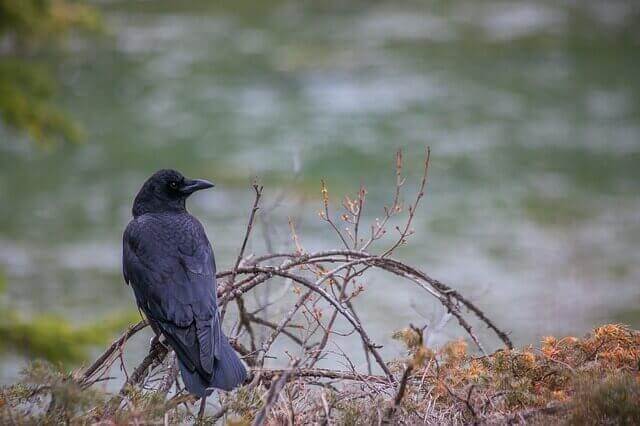
The American Crow is a medium-sized bird native to North America. It is a very common bird found across much of North America from the Southern States to the northern Plains states. It’s a popular, day-flying bird with a wide distribution across much of North America, from the Midwest to the Deep South.
The most distinctive feature of this species is its call, which is a high-pitched “wail” that echoes in field oases and deep lakes. They can be found in marshlands, deciduous woodlands, and floodplain forests,
- Frequency: 30.47%
- Color: Black
- Habitat: Open country, farms, parks, woodlands, towns, cities
- Range: Canada, USA, Mexico
- Size: 16 – 21″ inches
- Weight: 315 -620 grams
- Diet: invertebrates, carrion, seeds, eggs fish, grains, mice, frogs, and other small animals.
- Family: Corvidae
- Genus: Corvis
House Sparrow

The house sparrow is a common bird of the Passeridae family, common in all parts of the globe. It is actually a rather small bird with a standard length of only 6 inches and a mass of only 25 grams.
They are very common in North America, especially around the Great Lakes and Southern Canada. House sparrows are social birds that prefer to live in pairs, building nests in burrows or under eaves, trees, rocks, or anywhere they can find protection such as leaf piles or twigs.
- Frequency: 23.44%
- Color: Gray head marking, a reddish-brown back, and gray underparts
- Habitat: Urban centers, suburban areas, backyards, edges, yards, and parks
- Range: North America, Central America, South America, Africa, Australia, New Zealand
- Size: 5.5 – 7.1″ inches in length
- Weight: 25 – 39 grams
- Diet: Insects, beetles, caterpillars, aphids,, grasshoppers, crustaceans, earthworms, vertebrates
- Family: Passeridea
- Genus: Passer
Downy Woodpecker
The Downy Woodpecker is typically found in wooded areas in the eastern parts of the US and Canada. During spring, these birds are often seen around tree stumps and nesting areas. The Downy Woodpeckers diets tend to include many different types of insects, along with other types of seeds, including sunflower seeds.
In fact, they are among one of the most efficient insectivores in the world. They can even go long periods without eating. This trait allows them to live in large, swamped tree stands, or even in houses, although they prefer large trees where they can find lots of insects.
- Frequency: 22.34%
- Color: Black with a white throat, belly, and back. White spots on wings
- Habitat: Deciduous forests and thickets, roadside, grasslands, backyards, parks
- Range: Canada, USA, and Mexico
- Size: 5.5 – 7.1″ inches in length
- Weight: 20 – 33 grams
- Diet: Mostly insects and beetles and ants, also gall wasps, caterpillars
- Family: Picadae
- Genus: Dryobates
Northern Flicker
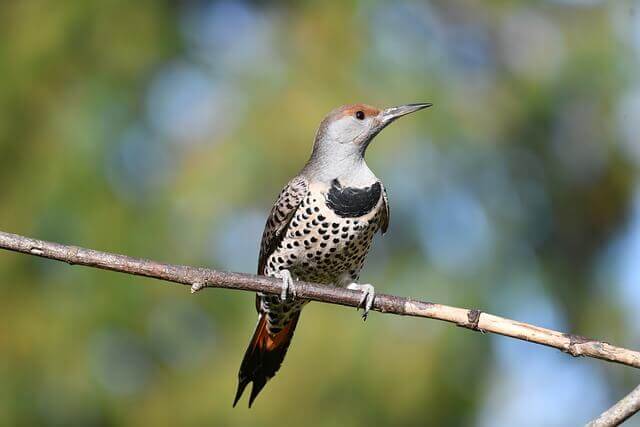
The Northern Flicker or common red flicker is an large woodpecker of the mid-sized woodpecker wood family. It is very common in the United States, Canada, parts of Central America, Cuba and the Cayman Islands, among other parts of the world.
It is also one of only two woodpeckers that regularly migrate, traveling from season to season. In addition, it is by far the most colorful bird among the upper-level woodpeckers. It has brown upper parts, black bars, black collar, cinnamon-orange tail, and a yellowish belly.
- Frequency: 21.58%
- Color: Light brown with black bars across back, chest, wings, belly
- Habitat: Forests, woodlands, backyards, edges, yards, and parks
- Range: North America, Central America, Cuba, Cayman Islands
- Size: 10 – 14″ inches
- Weight: 85 – 165 grams
- Diet: Insects (ants, beetles, invertebrates), fruits, seeds, berries
- Family: Picadae
- Genus: Colaptes
Red-breasted Nuthatch
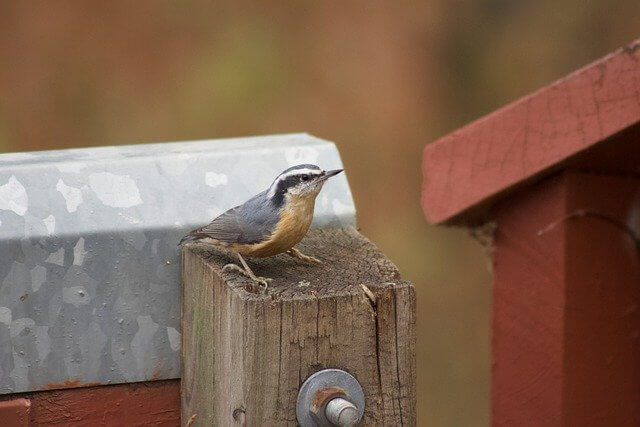
The Red-breasted Nuthatch are common bird species found in wooded areas, meadows, and along roadways. They are especially common in Central and Western North America, where they are frequently seen nesting in cliffs or undergrowth.
Unlike most North American coniferous birds, the Red-breasted nuthatch is not selective about the kind of seeds it eats. They will eat virtually any kind of seeds, even a variety of fruits such as blueberry, cranberries, and blackberries. It is best to use a variety of dried mixes including sunflower seeds, suet, millet and cracked corn.
- Frequency: 19.14%
- Color: Bluish gray upperparts with reddish brown underparts, a white face and throat with a black stripe runs through the eyes.
- Habitat: Coniferous trees but can also be found in mixed woods, backyards, and parks.
- Range: Canada and USA
- Size: 4.5″ inches long
- Weight: 9.9 grams
- Diet: Berries, suet, small seeds, carrion, grasshoppers, and various insect larvae, and crustaceans.
- Family: Sittidae
- Genus: Sitta
Red-winged Blackbird
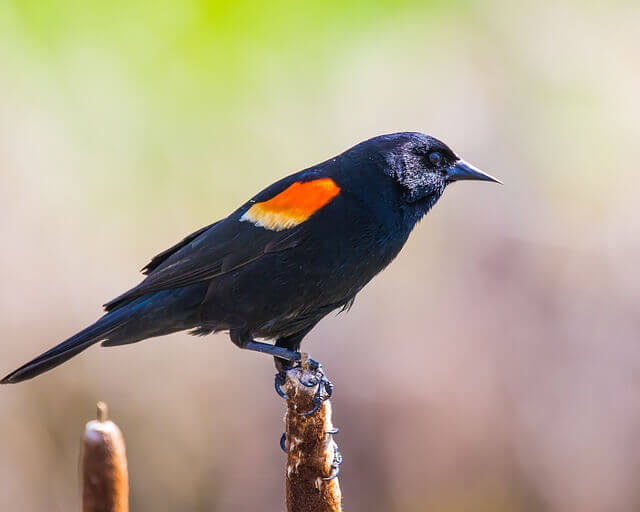
The Red-winged Blackbird is a common visitor to bird feeders because of its vibrant and vivid colors. These birds have an unusually large all black plumage with a red spot and a yellow band on its wings.
The male red-winged blackbird is larger than the female, they are about 8.7″ – 9.4″ inches in length and weighs approximately 64 grams. In the fall and winter the red-winged blackbird will migrate to central California and from there travel all across the United States and Canada.
- Frequency: 19.08%
- Color: All black with red patches on shoulder and a yellow wing bar
- Habitat: Deciduous forests, conifers, roadside, rivers, backyards, parks
- Range: North America, Central America
- Size: 6.7 – 7.1″ inches length
- Weight: 41.5 – 65 grams
- Diet: Seeds and insects (butterflies, dragonflies, moths, frogs, worms, spider, snails, carrion, flies.)
- Family: Icteridae
- Genus: Agelaius
Blue Jay
The Blue Jay is a passerine member of the family Corvidae, indigenous to central and eastern North America. It is often found in fields, meadows, along highways, swamps, streams, tributaries, and lakes. It lives primarily in all of the central and eastern states; populations can also be migratory. Blue jays are seldom seen in Canada, United States, and even Mexico.
Preferring to feed on the ground or on seeds, the blue jay feeds on a variety of vegetation from grass, reed, willow, and ash. During the spring and summer when food is abundant, these birds are quite active, flying around frequently in search of food. In urban areas, the Blue Jay finds its natural habitat in parks, backyards, cemeteries, and abandoned farms. These bird feeders provide them with a safe place to feed from and avoid being hunted.
- Frequency: 18.38%
- Color: Blue crest on the head, wings, back, and tail, and has a white face and belly
- Habitat: Deciduous and mixed forests, mixed woodlands, backyards, parks
- Range: Southern Canada, Eastern and Central United States, Florida and Texas
- Size: 8 – 12″ inches
- Weight: 70 – 100 grams
- Diet: Nuts, seeds, caterpillars, grasshoppers, and beetles
- Family: Corvidae
- Genus: Cyanocitta
European Starling
The European Starling, also called simply the common starling in Britain, is a medium-sized passerine bird from the Sturnidae family. It’s about 8″ long and has a plain metallic greenish-yellow feather that is speckled occasionally with white. These birds have yellowish green upperparts, with a splotchy yellow breast, and darkish flanks and tail – all white with some gray streaks. It has a short stout bill, and its crest contains white dots which may be faint or not, depending on the individual.
In autumn and winter flocks of these birds migrate to Canada and the northern United States. They breed in the North American part of Lake Erie along the west shore of the upper Mississippi River, although they may also go to southern Quebec and Labrador. During summer they nest near ponds, streams and islands in the southern states.
- Frequency: 16.30%
- Color: Black with glossy iridescence plumage
- Habitat: Forests, woodlands, backyards, edges, yards, and parks
- Range: North America, Europe, Africa, India, Middle East, China
- Size: 7 – 9″ inches long
- Weight: 60 – 100 grams
- Diet: Insects (ants, beetles, invertebrates), fruits, seeds, berries
- Family: Sturnidae
- Genus: Sturnus
Tree Swallow
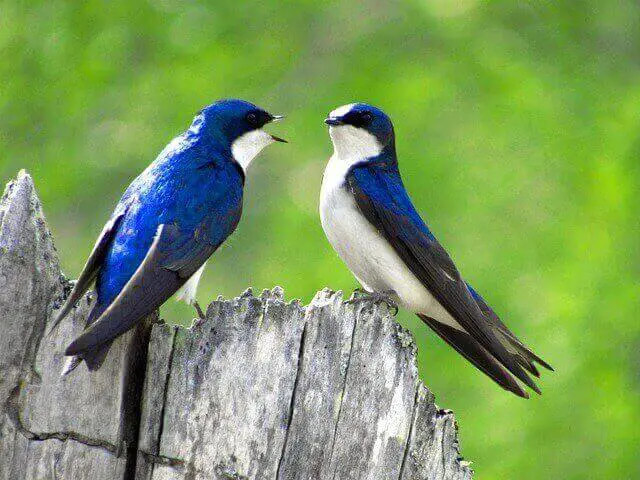
The Tree Swallow is a common migratory birds of the genus Hirundinidae, with an estimated number of around forty million birds worldwide. The tree swallows are primarily known from the lakes and rivers of North America and southern Mexico. These diving birds are typically found feeding on insects that float in the water.
During the spring and summer months the male tree swallows fly up into the upper reaches of the nesting trees where they start to search for potential mates. At this time they begin to build their nests in the branches of trees, often combining small twigs and flowers to make a nest.
- Frequency: 13.48%
- Color: Bluish-green upper with black wings and tail, and white underbody
- Habitat: Open wooded areas
- Range: USA, Canada, South America
- Size: 4.5 – 5.5″ inches
- Weight: 17 – 26 grams
- Diet: insects, molluscs, spiders, and fruit
- Family: Hirundinidae
- Genus: Tachycineta
Rock Pigeon
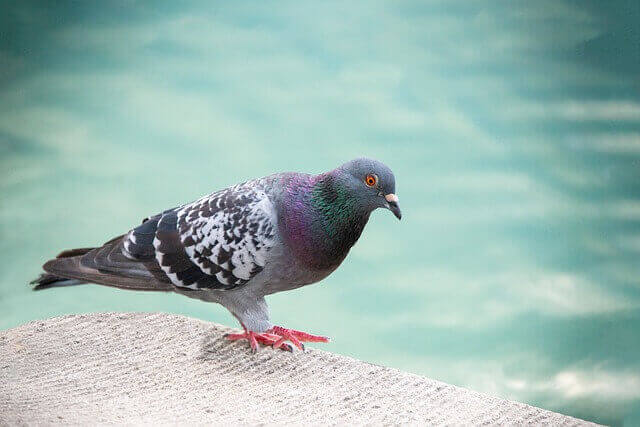
The Rock Pigeon, the common pigeon, or rock dove is part of the pigeon family Columbidae, a family of pigeons.Like most North American pigeons, the Rock Pigeon is primarily a winter visitor to bird feeders, although it will also visit feeders throughout the day. Rock Pigeons is common birds found in Canada, the eastern and central parts of the United States, primarily in states such as Illinois, Iowa, and Wisconsin.
They typically occur in deciduous forests, wooded areas, and near large cliffs, wooded trails, and open areas with cliffs. In urban areas, they can be found nesting near roads, in alleys, and along sidewalks. If you want to attract more of these intelligent birds, it would be a good idea to search for them during their time of migration, since they will likely congregate around bird feeders and bird baths.
- Frequency: 13.38%
- Color: Dark blue-gray head, neck, and chest with a yellow, green and red iridescence on its neck and wings.
- Habitat: Woodlands, marshes, meadows, parks, backyards, and fields
- Range: Europe, North Africa, South Asia, Canada and USA
- Size: 11 – 15″ inches long
- Weight: 235 – 380 grams
- Diet: They areomnivorous, but also like seeds, plant matter, sugary fruits and grains.
- Family: Columbidae
- Genus: Columba
White-breasted Nuthatch
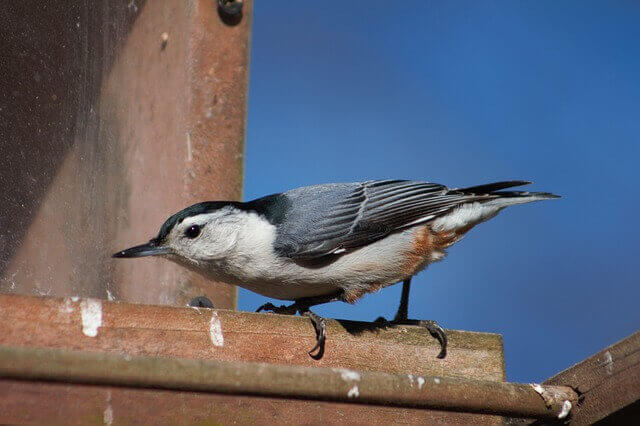
White-breasted Nuthatches are a small songbird of the nuthatch family.This species is rare and is not easily found in the wild. It is only found in southern Canada and the northern United States. The species usually breeds during May through June and starts to migrate south around July. They often nest on or near human structures and are also prone to eating carrion.
There are, however, populations of white-breasted nuthatches throughout the country, both migratory and local. In urban areas, you may occasionally see one nesting in an abandoned bird house. These birds are particularly common around the start of spring and early summer.
- Frequency: 12.85%
- Color: Has a white face, flanks, and chest. It has a black cap on its head a bluish-gray upper and a brown belly
- Habitat: Deciduous forests, conifers, roadside, rivers, backyards, parks
- Range: Southern Canada, USA
- Size: 5.9″ inches
- Weight: 20 grams
- Diet: Acorn nuts, hickory nuts, ants, caterpillars, scale insects, pine weevils
- Family: Sittidae
- Genus: Sitta
Yellow-rumped Warbler
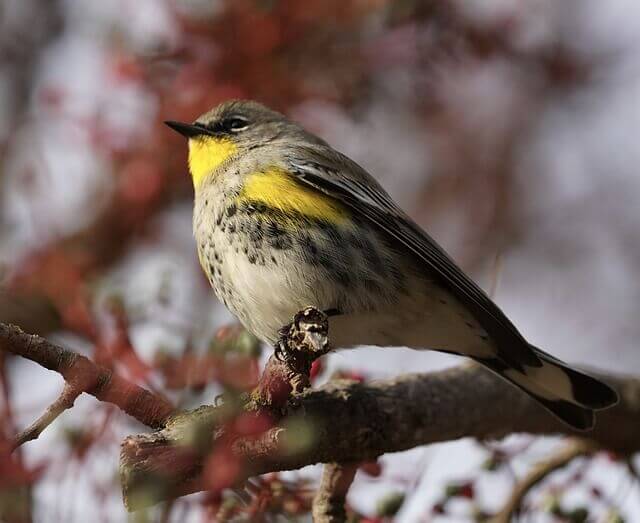
The Yellow-rumped Warbler, is an common North American species which is widely seen throughout the continent.The yellow-rumped warbler prefers a habitat that is cool and wet, including forested areas, open meadows, fields, swamps, and rocky cliffs. The birds have highly developed hearing and sight capabilities, which allow them to forage long distances and find food easily.
These birds are especially successful in spring, when they nest in large numbers and are especially abundant around nesting locations. This species is especially common in central and southern Canada, the United States, northern Mexico and the western part of Arizona.
- Frequency: 12.70%
- Color: Yellow patches on the crown,flanks, rump & blackish-blue streaks on the back, breast and wings
- Habitat: Deciduous forests and thickets, roadside, grasslands, backyards
- Range: U.SA, Canada, Mexico, Central America, and the Caribbean
- Size: 4.7 – 5.9″ inches
- Weight: 10 – 18 grams
- Diet: grasshoppers, gnats, aphids,caterpillars, wasps, beetles, spiders, berries,
- Family: Parulidae
- Genus: Setophaga
Dark-eyed Junco
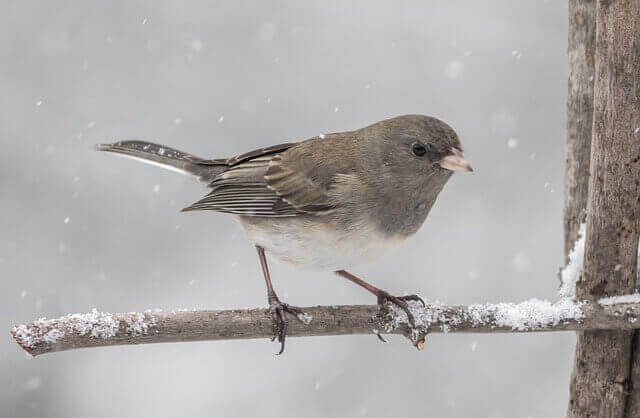
The Dark-eyed junco is a beautiful, species of bird is extremely common throughout much of North America and even into the southern reaches of the arctic.
These birds are typically seen in Canada, and the USA, where they feed on a number of different types of seeds, such as sunflower seeds, sesame seeds, peanuts, and chestnuts. In fact, the dark-eyed juncos are so common that you should not find it hard to spot them, as these birds are fairly easy to spot near bird feeders.
- Frequency: 12.62%
- Color: Gray head, neck, breast, gray/brown backs and wings, white underside
- Habitat: Wooded areas, forest edges, roadsides, gardens, parks.
- Range: USA and Canada
- Size: 5.1 – 6.9″ inches
- Weight: 18 – 30 grams
- Diet: Seeds, insects, and arthropods
- Family: Passeriformes
- Genus: Junco
House Finch
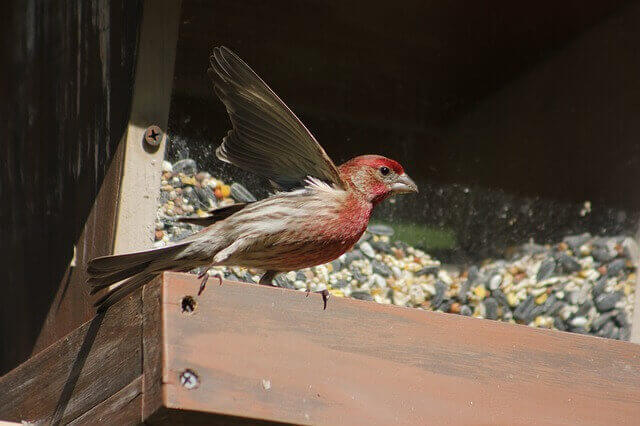
The House Finch is a beloved bird species among bird enthusiasts due to its charming appearance and social nature. These birds are widely distributed throughout the United States and Canada, as well as in Mexico, Central America, South America, and the Caribbean Islands. They are known for their gregarious behavior, living in flocks led by males and remaining together throughout the year.
While they forage for food together, House Finches are not scavengers and primarily eat seeds and insects. Breeding during the late part of the day, House Finches lay eggs in small nests either in tree branches or on the ground. Despite being diurnal birds, House Finches have also been known to exhibit nocturnal behavior. Overall, the House Finch is a fascinating and delightful bird species to observe and appreciate.
- Frequency: 12.36%
- Color: Reddish face and upper breast, brown streaks on back, belly, and tail.
- Habitat: urban and suburban areas, backyards, edges, yards, and parks
- Range: Canada, USA, Mexico
- Size: 5 – 6″ inches
- Weight: 16 – 27 grams
- Diet: Aphids, grains, seeds, berries, nettle, dandelion, sunflower
- Family: Fringillidae
- Genus: Haemorhous
Yellow Warbler
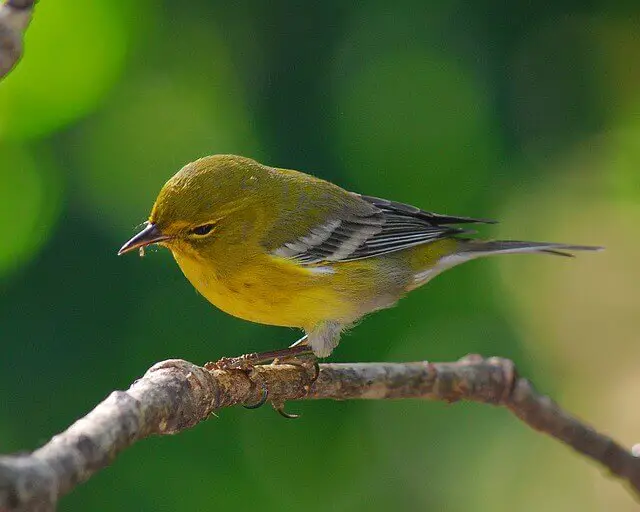
The Yellow Warbler is a common visitor to backyards. These birds are common in parks, meadows, near trails and wooded areas. They tend to forage in open fields during spring and early summer, but they may also forage in gardens. Yellow Warbler is the only species of the genus with a song that has a definite beat. Unlike most other songbirds, however, the yellow warblers arrive late in the year and prefer a more solitary life cycle with mate pair joining together only for mating.
During wintertime they seek out sheltered areas with food to mate and lay eggs. In addition to being a solitary hunter, the male Yellow Warbler feeds primarily on small insects such as moths, beetles, crickets, grasshoppers, ants, and spiders. To confuse things even more, male Yellow Warblers will display unnatural dancing while feeding.
- Frequency: 11.73%
- Color: Yellow with reddish streaks on the underparts
- Habitat: Pastures, thickets, brushy areas, prairies, grasslands, parks and fields,
- Range: USA and Canada
- Size: 4.0″ – 7.1″ inches long
- Weight: 7 – 25 grams
- Diet: Mayflies, moths, mosquitoes, beetles, damselflies, treehoppers, spiders, and berries.
- Family: Parulidae
- Genus: Setophaga
Clay-colored Sparrow
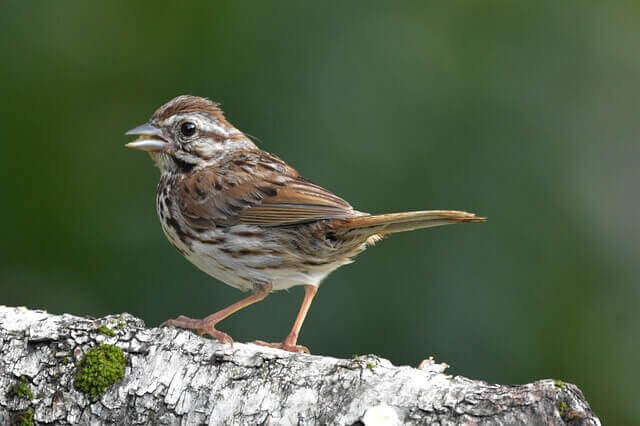
The clay-colored sparrow is a common species sparrows in North America. The life cycle for this species can be quite a bit longer than for other members of its genus, as it mates year round in both captivity and the wild. Because of the slow life cycle, these birds find it easier to obtain food, which makes them very easy to attract to bird feeders.
The clay-colored sparrow, are usually found on fields, abandoned farm equipment, along road sides, near bird baths, and in areas with an abundance of grass and weeds.The small size of the bird, its great capacity for feeding, and its relative ease of movement all make it one of the more popular species found in North America.
- Frequency: 11.29%
- Color: Light brown upper, and pale underparts, with dark streaks on the back and wings.
- Habitat: Thickets, shrublands, backyards, edges, yards, and parks.
- Range: USA and Canada
- Size: 5.1″ – 6.1″ inches long
- Weight: 12 grams
- Diet: Insects, beetles, caterpillars, aphids,, grasshoppers, crustaceans, earthworms, vertebrates
- Family: Passerellidae
- Genus: S. pallida
The Backyard Birds below have a Frequency of less than 12%.
- Northern Shoveler – 11.10% Frequency
- Song Sparrow 10.64%
- Cedar Waxwing 10.55%
- Pine Siskin 10.51%
- Savannah Sparrow 10.38%
- Hairy Woodpecker 10.26%
- Lesser Scaup 10.17%
- Chipping Sparrow 9.96%
- White-throated Sparrow 9.89%
- Killdeer 9.53%
- House Wren 9.51%
- American Goldfinch8.65%
- Brown-headed Cowbird 8.48%
- Least Flycatcher 7.06%
- Common Redpoll 6.24%
- Ruby-crowned Kinglet 6.17%
- Barn Swallow 6.14%
- Spotted Sandpiper 6.01%
- White-crowned Sparrow 5.93%
- Lincoln’s Sparrow 5.92%
- Wilson’s Snipe 5.81%
- Western Meadowlark 5.45%
- Yellow-headed Blackbird 5.41%
- Bohemian Waxwing 5.10%
- Boreal Chickadee 5.06%
Creating a Bird-Friendly Backyard
Creating a Bird-Friendly Backyard is an important way to promote and enhance the bird population in Alberta. By creating your own backyard sanctuary for birds, you can enjoy their beauty and song in their natural habitat.
Not only does it provide aesthetic pleasure, but it also helps preserve the health of the environment. Here are some tips on how to make your backyard bird-friendly and attract more birds to your home! When planning out your backyard sanctuary, consider adding native plants that will attract a variety of birds.
Some great choices for Alberta include blueberry bushes, elderberry shrubs, wild roses, sunflowers or even native grasses – all of which offer food sources or nesting materials that will entice feathered friends visiting your yard.
Setup up bird feeders with various types of seed as well as suet or hummingbird nectar. Then install shallow dishes filled with fresh water for drinking and bathing.
This can also be achieved by using birdbaths or fountains that are placed in sunny locations. These tips will also help encourage them to stay longer and visit often!
Conclusion
In conclusion, Alberta is an incredible place to observe and appreciate nature, especially birds. With over 432 species of birds in the province, you’re likely to spot a few of the 45 most common backyard birds while out on a walk.
Whether you’re an ornithologist or a novice bird lover, there’s something special about identifying these beautiful creatures. So grab your binoculars and head outdoors – explore your neighborhood and discover the avian wildlife around you!
Related Post: 30 Best Birding Spots in Canada (Your Ultimate Guide!)


